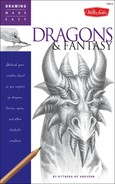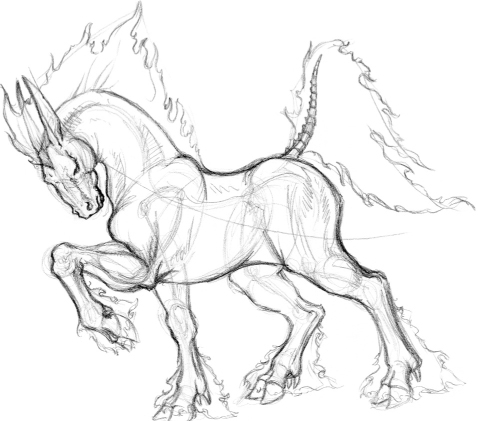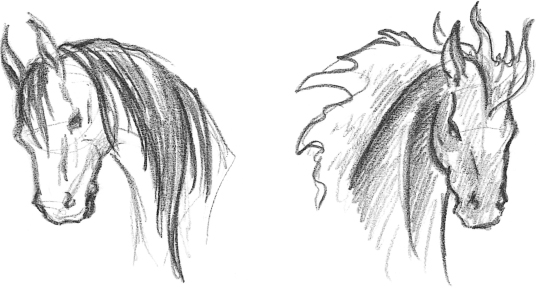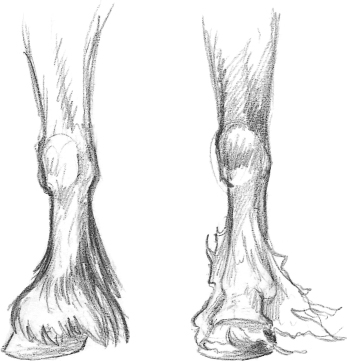Most of us think of nightmares as scary dreams, not fantasy creatures. The idea of a nightmare as a mystical horse is a fairly recent notion, but the fiery black creature has become popular in contemporary fiction and games as an antagonist or hostile spirit (true to its name). The most striking feature of the nightmare is that its mane and tail are composed of fire. Sometimes the creature is credited as breathing fire, blowing smoke from its nostrils, or even having flaming hooves. Fire can be a challenge to draw, so this lesson will explore adapting flames to work convincingly in place of hair.

Step 1 As usual, I draw the line of action first with an HB pencil. In this case, it’s a fairly simple arch, as I want to convey a powerful forward motion. I build up the lines of the figure to reflect this stance, with the neck arched and the closest foreleg lifted up—almost like the parade step of a well-trained dressage horse. Although I want my creature to convey a sense of elegance, I also want her to seem solid and powerful, like a heavy draft horse. To do this, I make her back a little shorter than a typical horse’s, making her seem more compact.

Step 2 Now I use basic shapes to develop the forms. I use large shapes for the mane and tail, providing room for the flames. I also draw long ears—a horse usually has smaller ears, but I want to suggest that this nightmare is associated with death, so I give her ears that resemble the jackal-headed Egyptian god of death and judgment, Anubis.
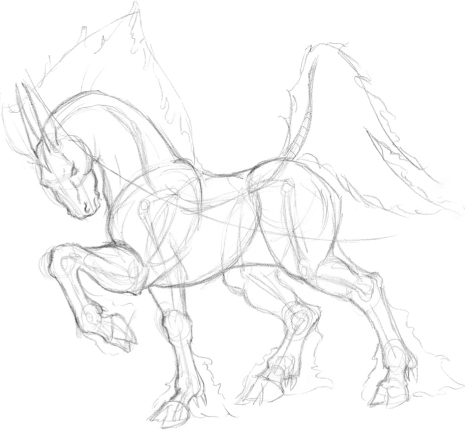
Step 3 Still using the HB pencil, I add more form to the muscles, making them look heavy and solid. I also add details to the face, such as the eyes, mouth, and nostrils. I indicate some flames on the edges of the mane and tail, and I add some flames around the hooves. I decide to make her hooves split like a cow’s—this makes her look otherworldly (as horses have solid hooves), and a bit scary, as we tend to associate split hooves with demons. I also start to indicate some of the bones of her tail.
Step 4 I like the direction I am taking with this drawing, so I keep adding details. I indicate the individual bones in her tail, more clearly define the shape of the flames, and render the muscles in more detail.

Step 5 Now I use my light table to transfer the lines I want to keep to a clean sheet of paper. I’m especially careful with the outline of the flames, drawing just light enough so I can see them. Because I know I want to keep the trailing edge of the flames light, it’s better to keep them light now and darken them later, rather than trying to lighten up dark lines.

Step 6 Using the HB pencil, I create the basic shadow areas with hatching. Because her coat is black, I’m not afraid to allow some of the areas to become darker than others across her body. Conversely, I’m very careful with the flames, only adding the lightest shading at the base for now.
Step 7 Now I change my method of shading to be very deliberate and careful. Though I start to use a softer 2B pencil as usual, I must keep in mind a very complicated lighting situation—the figure’s mane, tail, and hooves are all on fire! This has the effect of illuminating the figure from six different angles. Just as I darken the base of the flames a bit more, the edges of the forms adjacent to the base of the flames are lightest. This is especially noticeable around the feet, which are surrounded by flames and thus are most illuminated. Notice that I leave a light area along the underside of the belly and the bottom of the raised foreleg to show illumination. Finally, I add more details to the trailing edges of the flames. I’m very careful to keep the edges light, but I also let the lines “read” as delicate, wispy tendrils.
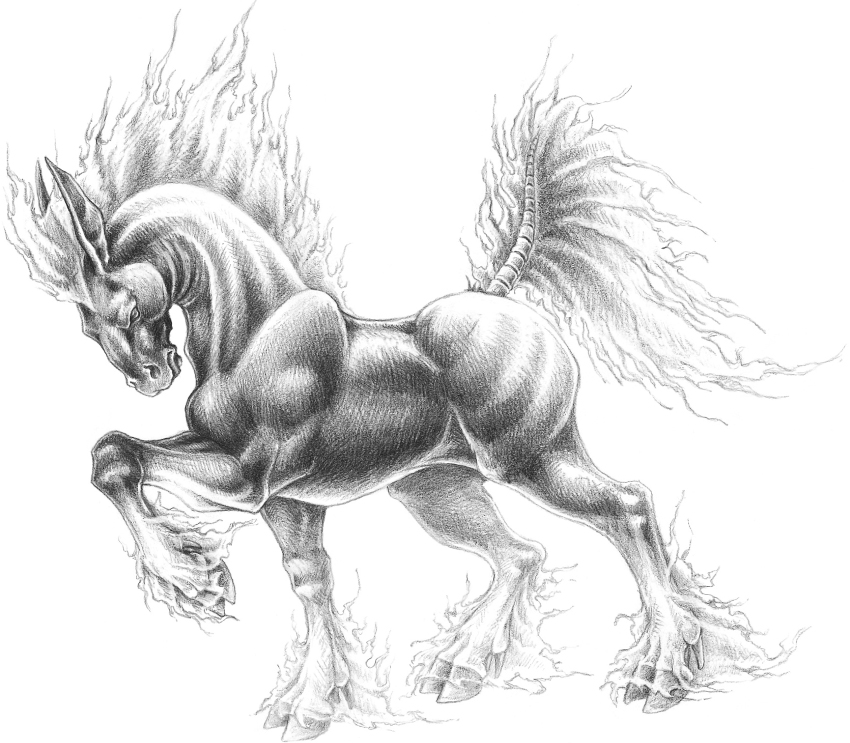
Step 8 To convey the darks of the black coat, I use softer pencils such as 3B and 4B. I use a kneaded eraser and a small stick eraser to lift out highlights along the neck, haunches, and the bottom of the raised leg. I also use the kneaded eraser to lighten the two back legs so they seem more distant. I add a few more darks to the base of the flames, giving them more dimension. I shade the ear on the other side of the mane just enough to make it visible through the flames, and I add more flames to the tail, covering the ridges at the top of the tailbone. Finally, I shade the eye. I saved this for last because it could make or break the drawing—and she does look appropriately mean!
